Accessibility and Connectivity Criteria for Assessing Walkability: An Application in Qazvin, Iran
Abstract
:1. Introduction
2. Literature Studies
2.1. Overview to Accessibility
2.2. Overview to Connectivity
3. Methodology
3.1. Data Collection and Analysis
3.2. Space Syntax Analysis
3.3. Aggregation Method
4. Case Study: Qazvin (Iran)
4.1. Urban Structure of Qazvin
4.2. Study Area delimitation
5. Results
6. Discussion
7. Conclusions
Author Contributions
Funding
Institutional Review Board Statement
Informed Consent Statement
Acknowledgments
Conflicts of Interest
References
- Barros, A.P.; Martínez, L.M.; Viegas, J.M. A New Approach to Understand Modal and Pedestrians Route in Portugal. Transp. Res. Proc. 2015, 10, 860–869. [Google Scholar] [CrossRef] [Green Version]
- Marquet, O.; Miralles-Guasch, C. Walking short distances. The socioeconomic drivers for the use of proximity in everyday mobility in Barcelona. Transp. Res. Part A Policy Pract. 2014, 70, 210–222. [Google Scholar] [CrossRef]
- Sarkar, C.; Gallacher, J.; Webster, C. Built environment configuration and change in body mass index: The Caerphilly Prospective Study (CaPS). Health Place 2013, 19, 33–44. [Google Scholar] [CrossRef]
- Berg, M.V.D.; Van Poppel, M.; Van Kamp, I.; Andrusaityte, S.; Balseviciene, B.; Cirach, M.; Danileviciute, A.; Ellis, N.; Hurst, G.; Masterson, D.; et al. Visiting green space is associated with mental health and vitality: A cross-sectional study in four European cities. Health Place 2016, 38, 8–15. [Google Scholar] [CrossRef] [PubMed]
- Wolf, I.D.; Wohlfart, T. Walking, hiking and running in parks: A multidisciplinary assessment of health and well-being benefits. Landsc. Urban Plan. 2014, 130, 89–103. [Google Scholar] [CrossRef]
- Cerin, E.; Leslie, E.; Du Toit, L.; Owen, N.; Frank, L.D. Destinations that matter: Associations with walking for transport. Health Place 2007, 13, 713–724. [Google Scholar] [CrossRef] [PubMed]
- Bahrainy, H.; Khosravi, H. The impact of urban design features and qualities on walkability and health in under-construction environments: The case of Hashtgerd New Town in Iran. Cities 2013, 31, 17–28. [Google Scholar] [CrossRef]
- Lamíquiz, P.J.; López-Domínguez, J. Effects of built environment on walking at the neighbourhood scale. A new role for street networks by modelling their configurational accessibility? Transp. Res. Part A Policy Pract. 2015, 74, 148–163. [Google Scholar] [CrossRef] [Green Version]
- Nasir, M.; Lim, C.P.; Nahavandi, S.; Creighton, D. A genetic fuzzy system to model pedestrian walking path in a built environment. Simul. Model. Pract. Theory 2014, 45, 18–34. [Google Scholar] [CrossRef]
- Ferrer, S.; Ruiz, T.; Mars, L. A qualitative study on the role of the built environment for short walking trips. Transp. Res. Part F Traffic Psychol. Behav. 2015, 33, 141–160. [Google Scholar] [CrossRef]
- Kim, S.; Park, S.; Lee, J.S. Meso- or micro-scale? Environmental factors influencing pedestrian satisfaction. Transp. Res. Part D Transp. Environ. 2014, 30, 10–20. [Google Scholar] [CrossRef]
- Arranz-López, A.; Soria-Lara, J.; López-Escolano, C.; Campos, Á.P. Retail Mobility Environments: A methodological framework for integrating retail activity and non-motorised accessibility in Zaragoza, Spain. J. Transp. Geogr. 2017, 58, 92–103. [Google Scholar] [CrossRef] [Green Version]
- Cubukcu, E.; Hepguzel, B.; Onder, Z.; Tumer, B. Active Living for Sustainable Future: A Model to Measure “Walk Scores” via Geographic Information Systems. Proc. Soc. Behav. Sci. 2015, 168, 229–237. [Google Scholar] [CrossRef] [Green Version]
- Talavera-Garcia, R.; Soria-Lara, J.A. Q-PLOS, developing an alternative walking index. A method based on urban design quality. Cities 2015, 45, 7–17. [Google Scholar] [CrossRef]
- Lefebvre-Ropars, G.; Morency, C.; Singleton, P.A.; Clifton, K.J. Spatial transferability assessment of a composite walkability index: The Pedestrian Index of the Environment (PIE). Transp. Res. Part D Transp. Environ. 2017, 57, 378–391. [Google Scholar] [CrossRef] [Green Version]
- Lwin, K.K.; Murayama, Y. Modelling of urban green space walkability: Eco-friendly walk score calculator. Comput. Environ. Urban Syst. 2011, 35, 408–420. [Google Scholar] [CrossRef]
- Peiravian, F.; Derrible, S.; Ijaz, F. Development and application of the Pedestrian Environment Index (PEI). J. Transp. Geogr. 2014, 39, 73–84. [Google Scholar] [CrossRef]
- Southworth, M. Designing the Walkable City. J. Urban Plan. Dev. 2005, 131, 246–257. [Google Scholar] [CrossRef]
- Bettignies, Y.; Meirelles, J.; Fernandez, G.; Meinherz, F.; Hoekman, P.; Bouillard, P.; Athanassiadis, A. The Scale-Dependent Behaviour of Cities: A Cross-Cities Multiscale Driver Analysis of Urban Energy Use. Sustainability 2019, 11, 3246. [Google Scholar] [CrossRef] [Green Version]
- Shatu, F.M.; Yigitcanlar, T.; Bunker, J. Shortest path distance vs. least directional change: Empirical testing of space syntax and geographic theories concerning pedestrian route choice behaviour. J. Transp. Geogr. 2019, 74, 37–52. [Google Scholar] [CrossRef]
- Koh, P.; Wong, Y. Influence of infrastructural compatibility factors on walking and cycling route choices. J. Environ. Psychol. 2013, 36, 202–213. [Google Scholar] [CrossRef]
- Mehta, V. Streets and social life in cities: A taxonomy of sociability. Urban Des. Int. 2019, 24, 16–37. [Google Scholar] [CrossRef]
- Torun, A.Ö.; Göçer, K.; Yeşiltepe, D.; Argın, G. Understanding the role of urban form in explaining transportation and recreational walking among children in a logistic GWR model: A spatial analysis in Istanbul, Turkey. J. Transp. Geogr. 2020, 82, 102617. [Google Scholar] [CrossRef]
- Guo, Z.; Loo, B.P. Pedestrian environment and route choice: Evidence from New York City and Hong Kong. J. Transp. Geogr. 2013, 28, 124–136. [Google Scholar] [CrossRef]
- Hoogendoorn, S.P.; Daamen, W.; Knoop, V.L.; Steenbakkers, J.; Sarvi, M. Macroscopic Fundamental Diagram for pedestrian networks: Theory and applications. Transp. Res. Proc. 2017, 23, 480–496. [Google Scholar] [CrossRef]
- Ewing, R.; Cervero, R. Travel and the Built Environment. J. Am. Plan. Assoc. 2010, 76, 265–294. [Google Scholar] [CrossRef]
- Handy, S.; Paterson, R.; Butler, K. Planning for Street Connectivity: Getting from Here to There; American Planning Association: Chicago, IL, USA, 2003. [Google Scholar]
- Agrawal, A.W.; Schlossberg, M.; Irvin, K. How Far, by Which Route and Why? A Spatial Analysis of Pedestrian Preference. J. Urban Des. 2008, 13, 81–98. [Google Scholar] [CrossRef]
- Kim, J.; Ahn, C.R.; Nam, Y. The influence of built environment features on crowdsourced physiological responses of pedestrians in neighborhoods. Comput. Environ. Urban Syst. 2019, 75, 161–169. [Google Scholar] [CrossRef]
- Jiang, B.; Liu, C. Street-based topological representations and analyses for predicting traffic flow in GIS. Int. J. Geogr. Inf. Sci. 2009, 23, 1119–1137. [Google Scholar] [CrossRef] [Green Version]
- Ståhle, A.; Marcus, L.; Karlström, A. Place Syntax: Geographic Accessibility with Axial Lines in GIS. Available online: http://spacesyntax.tudelft.nl/media/Long%20papers%20I/stahle.pdf (accessed on 20 February 2013).
- Sharmin, S.; Kamruzzaman, M. Meta-analysis of the relationships between space syntax measures and pedestrian movement. Transp. Rev. 2018, 38, 524–550. [Google Scholar] [CrossRef]
- Hillier, B.; Iida, S. Network effects and psychological effects: A theory of urban movement. In Proceedings of the Fifth International Space Syntax Symposium, Delft, The Netherlands, 13–17 June 2005. [Google Scholar]
- Turner, A. From Axial to Road-Centre Lines: A New Representation for Space Syntax and a New Model of Route Choice for Transport Network Analysis. Environ. Plan. B Plan. Des. 2007, 34, 539–555. [Google Scholar] [CrossRef] [Green Version]
- Acheampong, R.A. Spatial structure, intra-urban commuting patterns and travel mode choice: Analyses of relationships in the Kumasi Metropolis, Ghana. Cities 2020, 96, 102432. [Google Scholar] [CrossRef]
- Moura, F.; Cambra, P.; Gonçalves, A.B. Measuring walkability for distinct pedestrian groups with a participatory assessment method: A case study in Lisbon. Landsc. Urban Plan. 2017, 157, 282–296. [Google Scholar] [CrossRef]
- Kim, J.; Tak, S.; Bierlaire, M.; Yeo, H. Trajectory Data Analysis on the Spatial and Temporal Influence of Pedestrian Flow on Path Planning Decision. Sustainability 2020, 12, 10419. [Google Scholar] [CrossRef]
- Vale, D.S.; Saraiva, M.; Pereira, M. Active accessibility: A review of operational measures of walking and cycling accessibility. J. Transp. Land Use 2015, 9. [Google Scholar] [CrossRef]
- Batty, M. Distance in Space Syntax. Available online: https://core.ac.uk/display/1668916 (accessed on 3 June 2016).
- Bafna, S. Space Syntax: A Brief Introduction to Its Logic and Analytical Techniques. Environ. Behav. 2003, 35, 17–29. [Google Scholar] [CrossRef]
- Charalambous, N.; Mavridou, M. Space Syntax: Spatial Integration Accessibility and Angular Segment Analysis by Metric Distance (ASAMeD). In Accessibility Instruments for Planning Practice; Hull, A., Silva, C., Bertolini, L., Eds.; COST Office: Amsterdam, The Netherlands, 2012; pp. 57–62. [Google Scholar]
- Istrate, A.-L.; Bosák, V.; Nováček, A.; Slach, O. How Attractive for Walking Are the Main Streets of a Shrinking City? Sustainability 2020, 12, 6060. [Google Scholar] [CrossRef]
- Bathrellos, G.D.; Skilodimou, H.D. Land Use Planning for Natural Hazards. Land 2019, 8, 128. [Google Scholar] [CrossRef] [Green Version]
- Rinzivillo, S.; Mainardi, S.; Pezzoni, F.; Coscia, M.; Pedreschi, D.; Giannotti, F. Discovering the Geographical Borders of Human Mobility. Künstliche Intelligenz 2012, 26, 253–260. [Google Scholar] [CrossRef]
- Wang, T.; Yue, W.; Ye, X.; Liu, Y.; Lu, D. Re-evaluating polycentric urban structure: A functional linkage perspective. Cities 2020, 101, 102672. [Google Scholar] [CrossRef]
- Zhong, C.; Arisona, S.M.; Huang, X.; Batty, M.; Schmitt, G. Detecting the dynamics of urban structure through spatial network analysis. Int. J. Geogr. Inf. Sci. 2014, 28, 2178–2199. [Google Scholar] [CrossRef]
- Seong, E.Y.; Lee, N.H.; Choi, C.G. Relationship between Land Use Mix and Walking Choice in High-Density Cities: A Review of Walking in Seoul, South Korea. Sustainability 2021, 13, 810. [Google Scholar] [CrossRef]
- Karimi, K. A configurational approach to analytical urban design: ‘Space syntax’ methodology. Urban Des. Int. 2012, 17, 297–318. [Google Scholar] [CrossRef]
- Koohsari, M.J.; Owen, N.; Cerin, E.; Giles-Corti, B.; Sugiyama, T. Walkability and walking for transport: Characterizing the built environment using space syntax. Int. J. Behav. Nutr. Phys. Act. 2016, 13, 1–9. [Google Scholar] [CrossRef] [Green Version]
- McCormack, G.R.; Koohsari, M.J.; Turley, L.; Nakaya, T.; Shibata, A.; Ishii, K.; Yasunaga, A.; Oka, K. Evidence for urban design and public health policy and practice: Space syntax metrics and neighborhood walking. Health Place 2021, 67, 102277. [Google Scholar] [CrossRef]
- Baran, P.K.; Rodríguez, D.A.; Khattak, A.J. Space Syntax and Walking in a New Urbanist and Suburban Neighbourhoods. J. Urban Des. 2008, 13, 5–28. [Google Scholar] [CrossRef]
- Dias, N.; Keraminiyage, K.; Amaratunga, D.; Curwell, S. Critical success factors of a bottom up urban design process to deliver sustainable urban designs. Int. J. Strat. Prop. Manag. 2018, 22, 265–277. [Google Scholar] [CrossRef]
- Broth, M.; Mondada, L. Delaying moving away: Place, mobility, and the multimodal organization of activities. J. Pragmat. 2019, 148, 44–70. [Google Scholar] [CrossRef]
- Mondada, L. Emergent focused interactions in public places: A systematic analysis of the multimodal achievement of a common interactional space. J. Pragmat. 2009, 41, 1977–1997. [Google Scholar] [CrossRef]
- Urquizo, J.; Calderón, C.; James, P. Metrics of urban morphology and their impact on energy consumption: A case study in the United Kingdom. Energy Res. Soc. Sci. 2017, 32, 193–206. [Google Scholar] [CrossRef]
- Ariza-Villaverde, A.B.; Jiménez-Hornero, F.J.; De Ravé, E.G. Multifractal analysis of axial maps applied to the study of urban morphology. Comput. Environ. Urban Syst. 2013, 38, 1–10. [Google Scholar] [CrossRef]
- Koohsari, M.J.; Sugiyama, T.; Mavoa, S.; Villanueva, K.; Badland, H.; Giles-Corti, B.; Owen, N. Street network measures and adults’ walking for transport: Application of space syntax. Health Place 2016, 38, 89–95. [Google Scholar] [CrossRef]
- Hillier, B.; Vaughan, L. The city as one thing. Prog. Plan. 2007, 67. [Google Scholar] [CrossRef] [Green Version]
- Hillier, B.; Hanson, J. The Social Logic of Space; Cambridge University Press (CUP): Cambridge, UK, 1984. [Google Scholar]
- Hillier, B.; Penn, A.; Hanson, J.; Grajewski, T.; Xu, J. Natural movement: Or, configuration and attraction in urban pedestrian movement. Environ. Plan. B 1993, 20, 29–66. [Google Scholar] [CrossRef] [Green Version]
- Chiang, Y.-C.; Deng, Y. City gate as key towards sustainable urban redevelopment: A case study of ancient Gungnae City within the modern city of Ji’an. Habitat Int. 2017, 67, 1–12. [Google Scholar] [CrossRef]
- Jeong, S.K.; Ban, Y.U. A point-based angular analysis model for identifying attributes of spaces at nodes in street networks. Phys. A Stat. Mech. Its Appl. 2016, 450, 71–84. [Google Scholar] [CrossRef]
- Abass, Z.I.; Tucker, R. Residential satisfaction in low-density Australian suburbs: The impact of social and physical context on neighbourhood contentment. J. Environ. Psychol. 2018, 56, 36–45. [Google Scholar] [CrossRef]
- Van Wee, B. Accessible accessibility research challenges. J. Transp. Geogr. 2016, 51, 9–16. [Google Scholar] [CrossRef] [Green Version]
- Koohsari, M.J.; Oka, K.; Owen, N.; Sugiyama, T. Natural movement: A space syntax theory linking urban form and function with walking for transport. Health Place 2019, 58, 102072. [Google Scholar] [CrossRef]
- Hajrasouliha, A.; Yin, L. The impact of street network connectivity on pedestrian volume. Urban Stud. 2015, 52, 2483–2497. [Google Scholar] [CrossRef]
- Lerman, Y.; Rofè, Y.; Omer, I. Using Space Syntax to Model Pedestrian Movement in Urban Transportation Planning. Geogr. Anal. 2014, 46, 392–410. [Google Scholar] [CrossRef]
- McIlvenny, P.; Broth, M.; Haddington, P. Communicating place, space and mobility. J. Pragmat. 2009, 41, 1879–1886. [Google Scholar] [CrossRef]
- Chiaradia, A.J.; Hillier, B.; Schwander, C.; Barnes, Y. Compositional and urban form effects on residential property value patterns in Greater London. Proc. Inst. Civ. Eng. Urban Des. Plan. 2013, 166, 176–199. [Google Scholar] [CrossRef]
- Peponis, J.; Ross, C.; Rashid, M. The structure of urban space, movement and co-presence: The case of Atlanta. Geoforum 1997, 28, 341–358. [Google Scholar] [CrossRef]
- Hillier, B.; Burdett, R.; Penn, A. Creating life: Or, does architecture determine anything? Archit. and Behav. 1987, 3, 233–250. [Google Scholar]
- Hillier, B.; Hanson, J. Space Syntax as a research programme. Urban Morphol. 1998, 2, 108–110. [Google Scholar]
- Cutini, V. Motorways in Metropolitan Areas: The Northwestern Growth of Florence and the Urban Use of Motorway A1. ISPRS Int. J. Geo-Inf. 2016, 5, 77. [Google Scholar] [CrossRef] [Green Version]
- Penn, A.; Hilllier, B.; Bannister, D.; Xu, J. Configurational modelling of urban movement networks. Environ. Plan. B Plan. Des. 1998, 25, 59–84. [Google Scholar] [CrossRef] [Green Version]
- Ozbil, A.; Peponis, J.; Stone, B. Understanding the link between street connectivity, land use and pedestrian flows. Urban Des. Int. 2011, 16, 125–141. [Google Scholar] [CrossRef]
- Omer, I.; Kaplan, N. Using space syntax and agent-based approaches for modeling pedestrian volume at the urban scale. Comput. Environ. Urban Syst. 2017, 64, 57–67. [Google Scholar] [CrossRef]
- Gorsevski, V.; Donevska, K.R.; Mitrovski, C.D.; Frizado, J.P. Integrating multi-criteria evaluation techniques with geographic information systems for landfill site selection: A case study using ordered weighted average. J. Waste Manag. 2012, 32, 287–296. [Google Scholar] [CrossRef] [PubMed]
- Jabbari, M.; Fonseca, F.; Ramos, R. Combining multi-criteria and space syntax analysis to assess a pedestrian network: The case of Oporto. J. Urban Des. 2017, 23, 23–41. [Google Scholar] [CrossRef]
- Tianxiang, Y.; Dong, J.; Shoubing, W. Applying and exploring a new modeling approach of functional connectivity regarding ecological network: A case study on the dynamic lines of space syntax. Ecol. Model. 2015, 318, 126–137. [Google Scholar]
- Wang, S.; Gu, K. Pingyao: The historic urban landscape and planning for heritage-led urban changes. Cities 2020, 97, 102489. [Google Scholar] [CrossRef]
- Alexander, C.; Ishikawa, S.; Silverstein, M.; Jacobson, M.; Fiksdahl-King, I.; Angel, S. A Pattern Language: Towns, Buildings, Construction; Oxford University Press: New York, NY, USA, 1977. [Google Scholar]
- Jayasinghe, A.; Sano, K.; Kasemsri, R.; Nishiuchi, H. Travelers’ Route Choice: Comparing Relative Importance of Metric, Topological and Geometric Distance. Proc. Eng. 2016, 142, 18–25. [Google Scholar] [CrossRef] [Green Version]
- Xia, Y.; Zhang, L.; Liu, Y. Special issue on big data driven Intelligent Transportation Systems. Neurocomputing 2016, 181, 1–3. [Google Scholar] [CrossRef]
- Su, S.; Zhou, H.; Xu, M.; Ru, H.; Wang, W.; Weng, M. Auditing street walkability and associated social inequalities for planning implications. J. Transp. Geogr. 2019, 74, 62–76. [Google Scholar] [CrossRef]
- Jung, S.-I.; Hong, K.-S. Deep network aided by guiding network for pedestrian detection. Pattern Recognit. Lett. 2017, 90, 43–49. [Google Scholar] [CrossRef]
- Azmi, D.I.; Ahmad, P. A GIS Approach: Determinant of Neighbourhood Environment Indices in Influencing Walkability between Two Precincts in Putrajaya. Proc. Soc. Behav. Sci. 2015, 170, 557–566. [Google Scholar] [CrossRef] [Green Version]
- Forés, V.I.; Bovea, M.; Belis, V.P. A holistic review of applied methodologies for assessing and selecting the optimal technological alternative from a sustainability perspective. J. Clean. Prod. 2014, 70, 259–281. [Google Scholar] [CrossRef]
- Pourjafar, M.; Amini, M.; Varzaneh, E.H.; Mahdavinejad, M. Role of bazaars as a unifying factor in traditional cities of Iran: The Isfahan bazaar. Front. Arch. Res. 2014, 3, 10–19. [Google Scholar] [CrossRef] [Green Version]
- Sharifi, A.; Murayama, A. Changes in the traditional urban form and the social sustainability of contemporary cities: A case study of Iranian cities. Habitat Int. 2013, 38, 126–134. [Google Scholar] [CrossRef]
- Alidoust, S.; Bosman, C. Master planned communities for the ageing population: How sociable are they? Cities Health 2017, 1, 38–46. [Google Scholar] [CrossRef]
- Jabbari, M. Documenting Urban Elements and Their Relation with Qazvin (Iran) Urban Structure 2007; Cultural Heritage Organization of Qazvin: Qazvin, Iran, 2007; pp. 1–152. [Google Scholar]
- Badia, H.; Estrada, M.; Robusté, F. Bus network structure and mobility pattern: A monocentric analytical approach on a grid street layout. Transp. Res. Part B Methodol. 2016, 93, 37–56. [Google Scholar] [CrossRef] [Green Version]
- Ahlfeldt, G.M.; Wendland, N. How polycentric is a monocentric city? J. Econ. Geogr. 2013, 13, 53–83. [Google Scholar] [CrossRef] [Green Version]
- Fujita, M.; Ogawa, H. Multiple equilibria and structural transition of non-monocentric urban configurations. Reg. Sci. Urban Econ. 1982, 12, 161–196. [Google Scholar] [CrossRef]
- Norouzian-Maleki, S.; Bell, S.; Hosseini, S.-B.; Faizi, M. Developing and testing a framework for the assessment of neighbourhood liveability in two contrasting countries: Iran and Estonia. Ecol. Indic. 2015, 48, 263–271. [Google Scholar] [CrossRef] [Green Version]
- Farkisch, H.; Ahmadi, V.; Che-Ani, A.I. Evaluation of neighborhood center attributes on resident’s territoriality and sense of belonging a case study in Boshrooyeh, Iran. Habitat Int. 2015, 49, 56–64. [Google Scholar] [CrossRef]
- Kerr, J.; Frank, L.; Sallis, J.F.; Chapman, J.E. Urban form correlates of pedestrian travel in youth: Differences by gender, race-ethnicity and household attributes. Transp. Res. Part D Transp. Environ. 2007, 12, 177–182. [Google Scholar] [CrossRef]
- Song, G.-S.; Jeong, M.-A. Morphology of pedestrian roads and thermal responses during summer, in the urban area of Bucheon city, Korea. Int. J. Biometeorol. 2016, 60, 999–1014. [Google Scholar] [CrossRef]
- Zhao, P.; Diao, J.; Li, S. The influence of urban structure on individual transport energy consumption in China’s growing cities. Habitat Int. 2017, 66, 95–105. [Google Scholar] [CrossRef]
- Kumar, P.; Rosenberger, J.M.; Iqbal, G.M.D. Mixed integer linear programming approaches for land use planning that limit urban sprawl. Comput. Ind. Eng. 2016, 102, 33–43. [Google Scholar] [CrossRef]
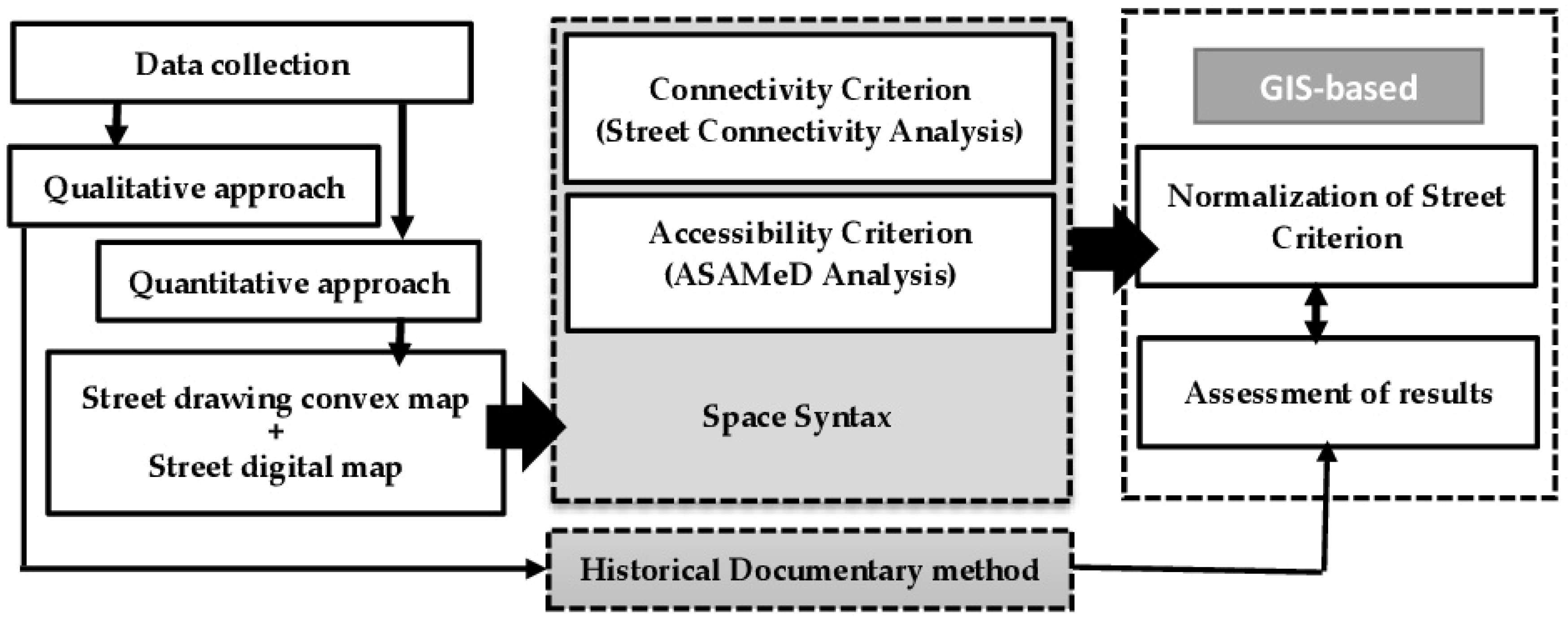

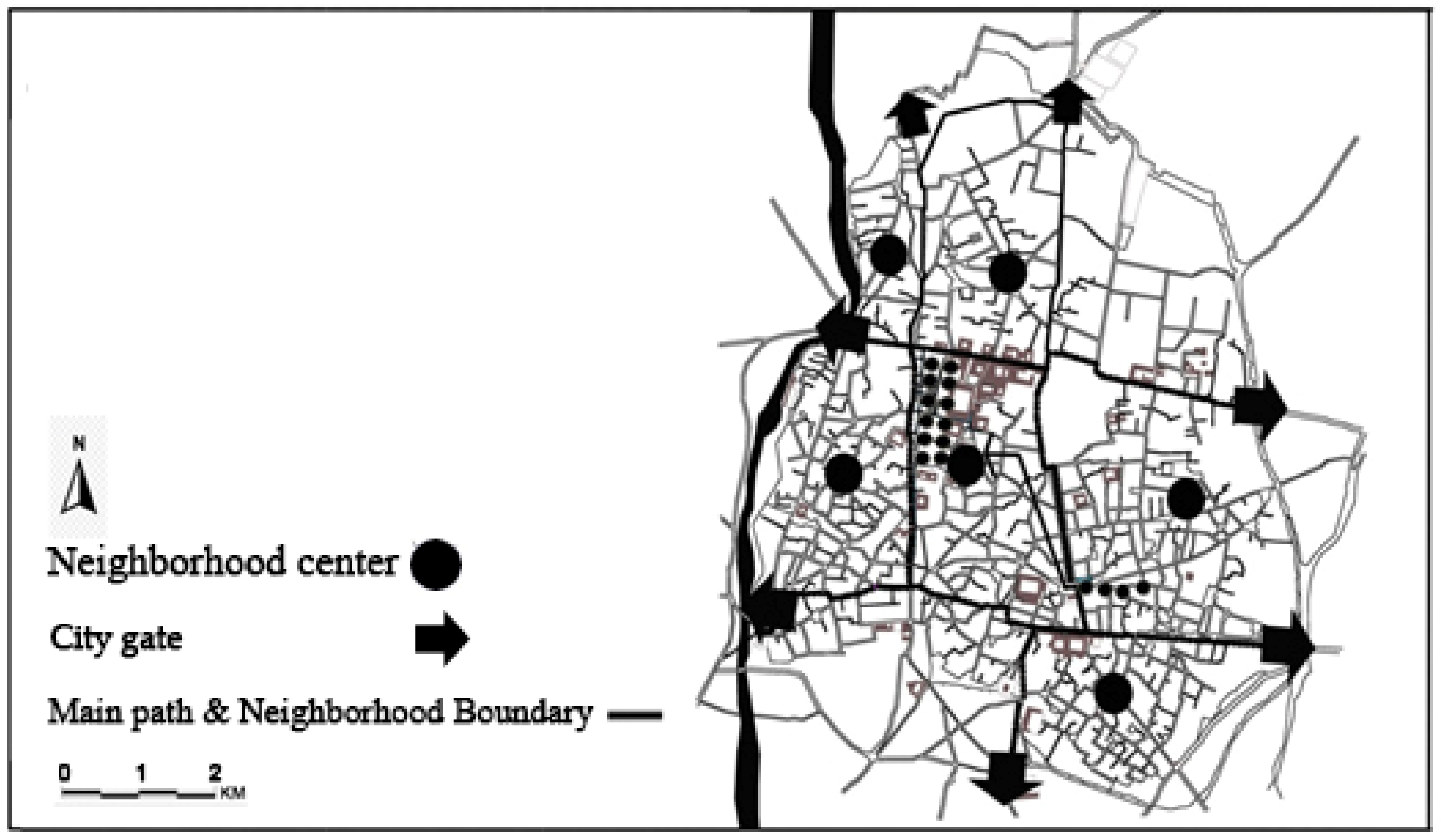
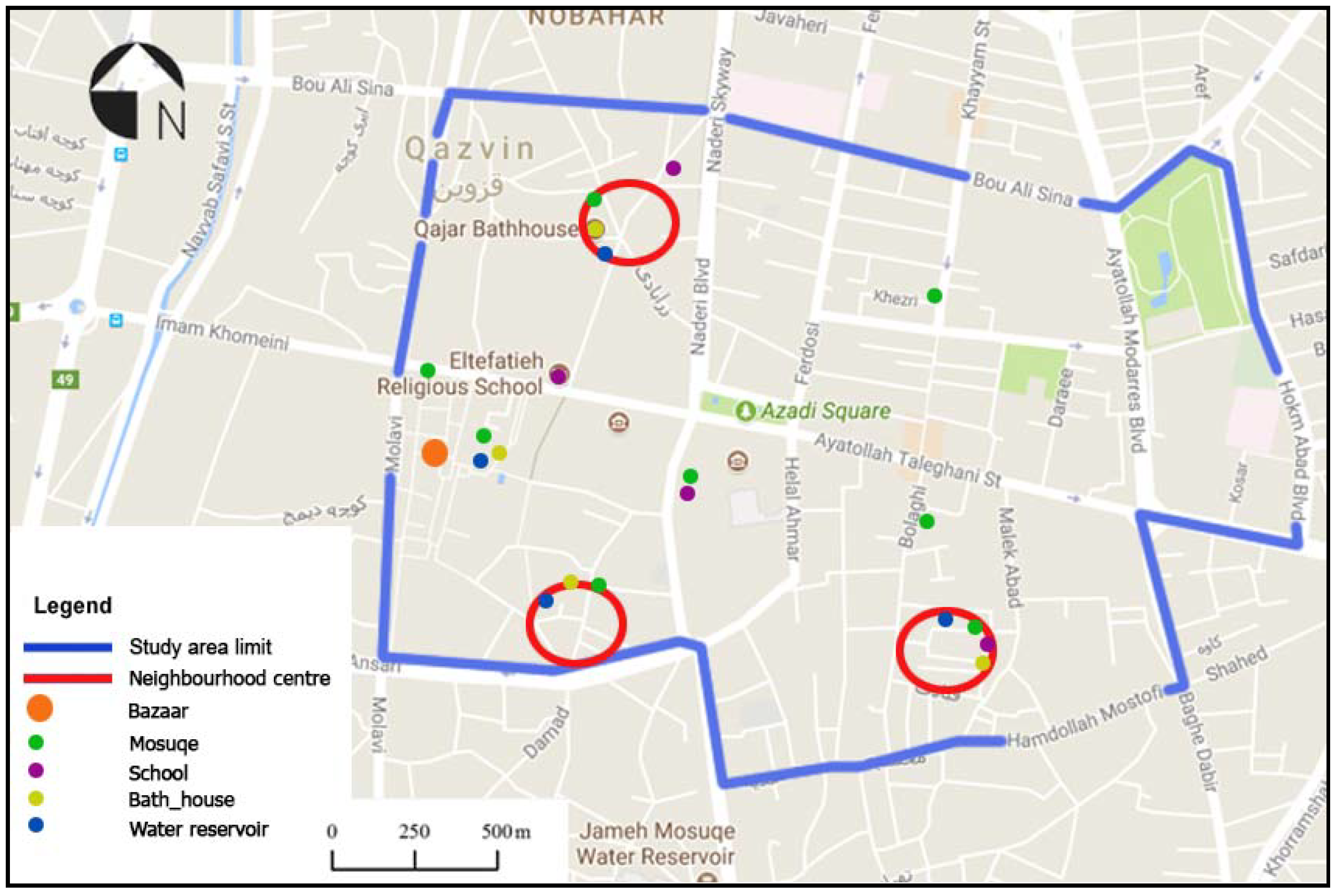
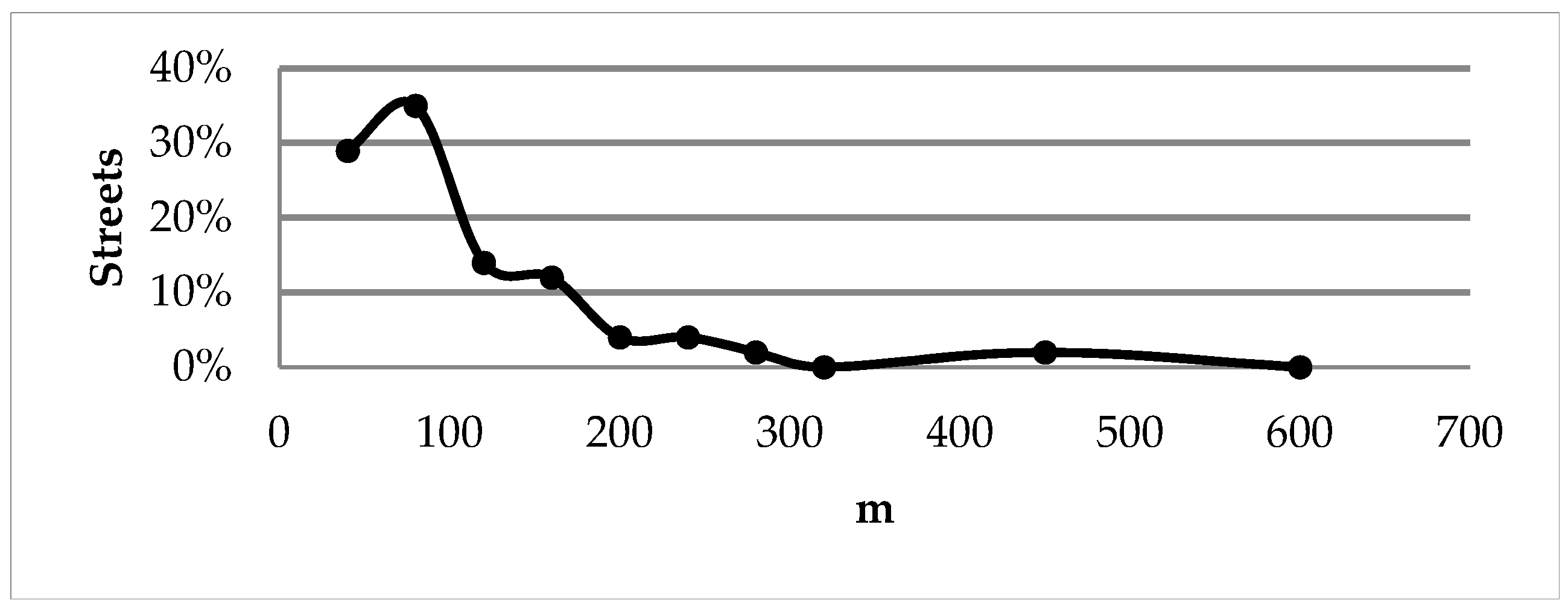

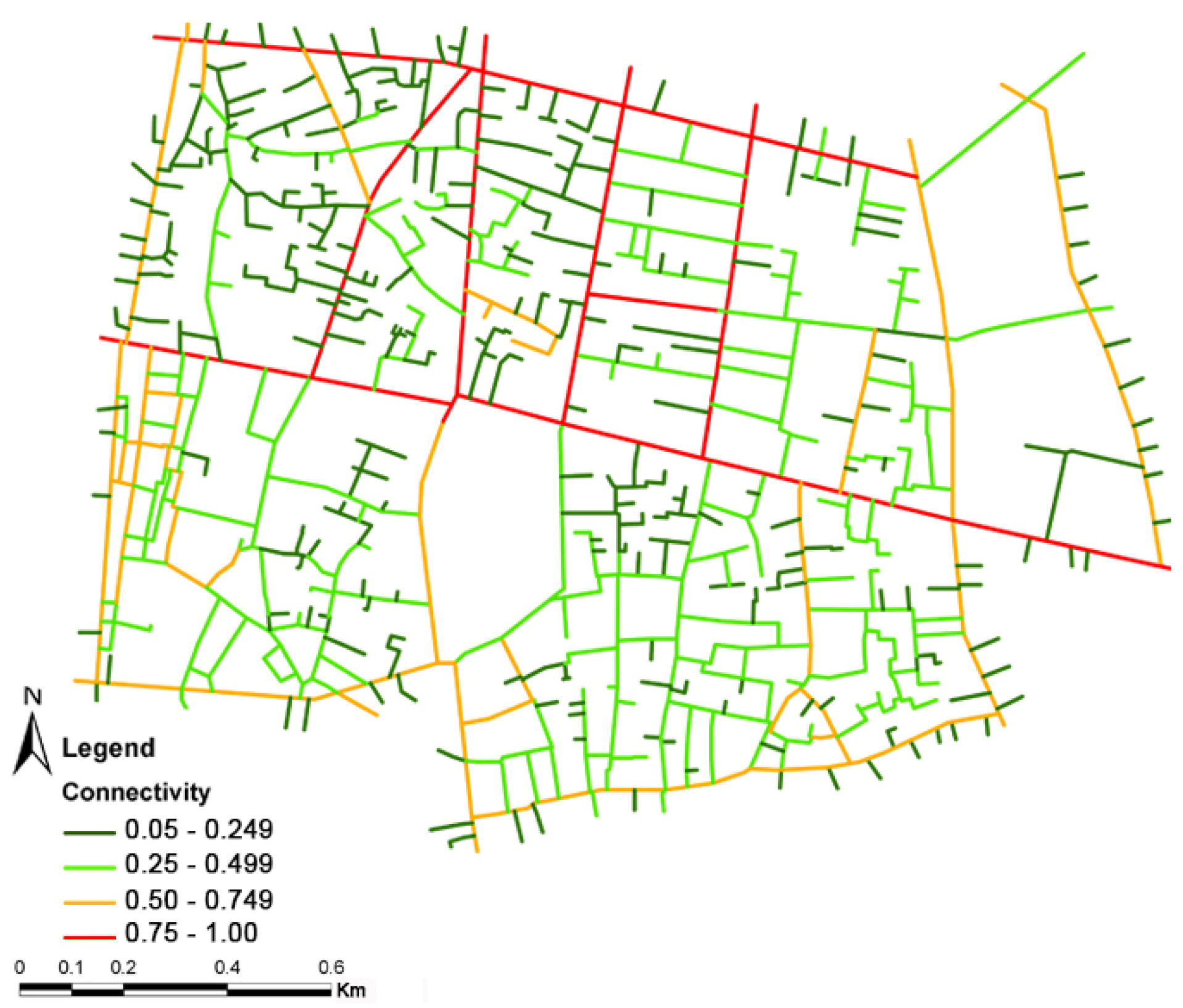
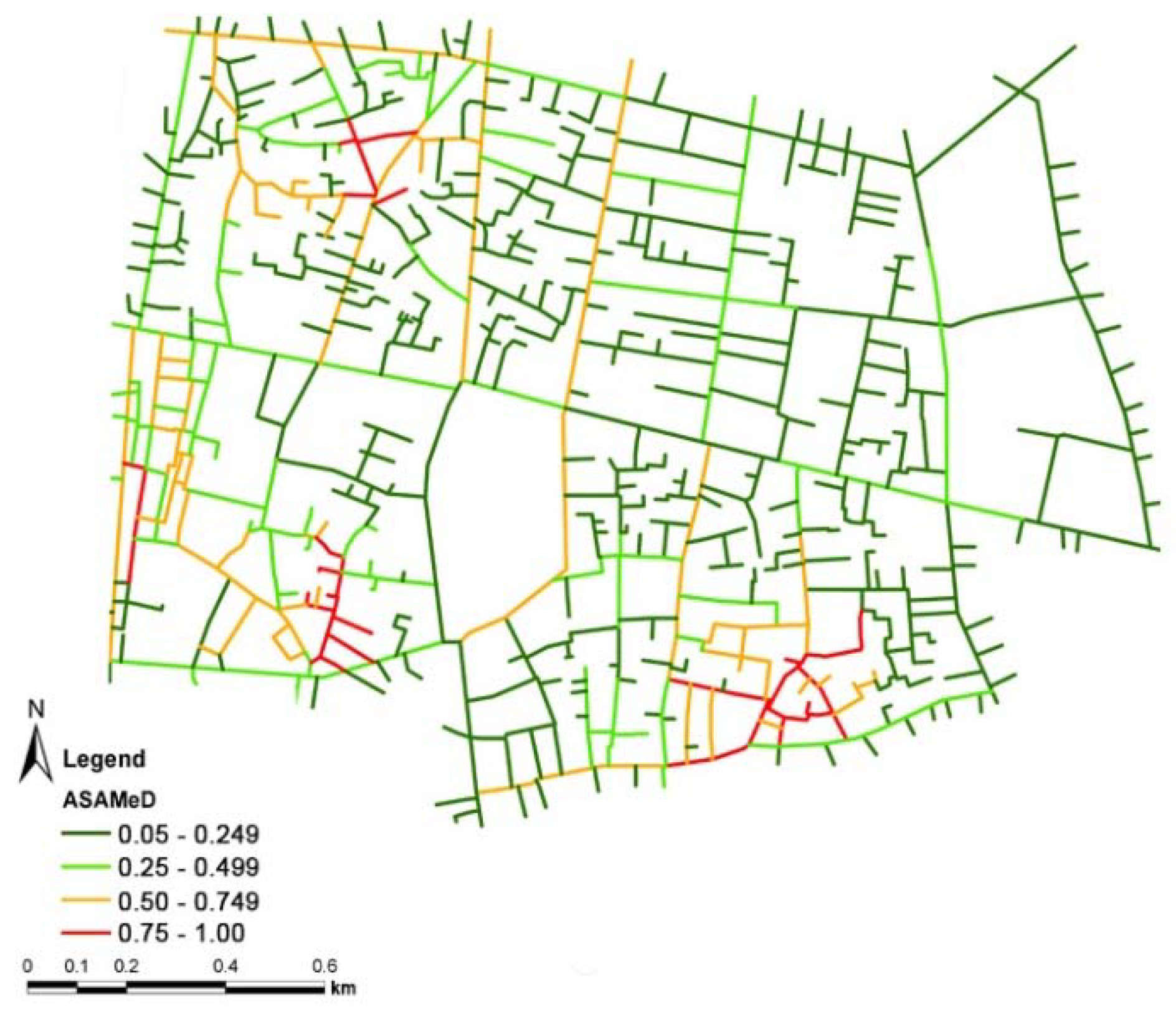
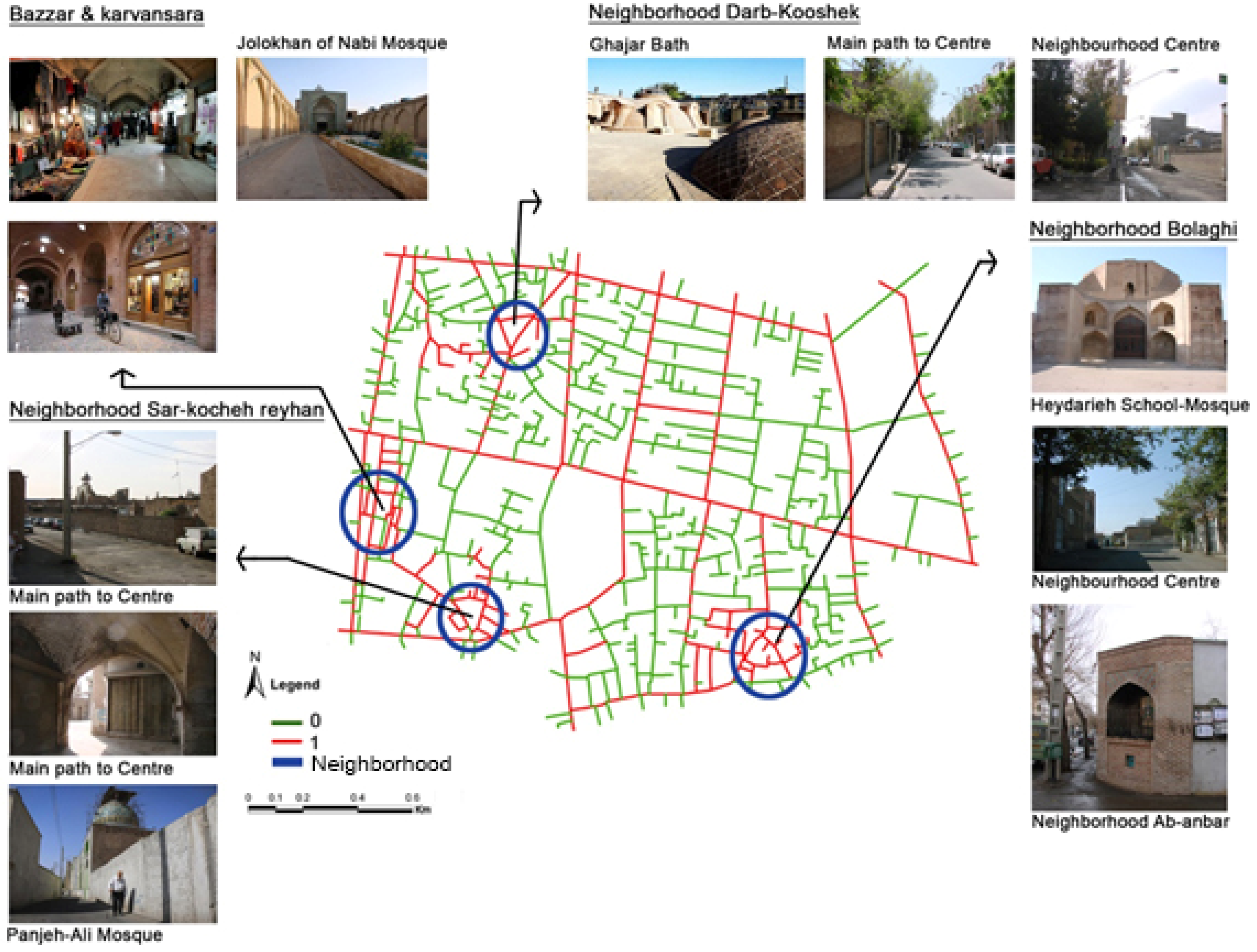
| Street Connectivity | ASAMeD | ||||
|---|---|---|---|---|---|
| Score | Normalized Values | Score | Normalized Values | Score | Normalized Values |
| 1 | 0 | 12 | 0.55 | 1–25 | 0.05 |
| 2 | 0.05 | 13 | 0.6 | 26–50 | 0.25 |
| 3 | 0.1 | 14 | 0.65 | 51–75 | 0.45 |
| 4 | 0.15 | 15 | 0.7 | 76–100 | 0.65 |
| 5 | 0.2 | 16 | 0.75 | 101–125 | 0.85 |
| 6 | 0.25 | 17 | 0.8 | 126–150 | 1.00 |
| 7 | 0.3 | 18 | 0.85 | ||
| 8 | 0.35 | 19 | 0.9 | ||
| 9 | 0.4 | 20 | 0.95 | ||
| 10 | 0.45 | 21 | 1.00 | ||
| 11 | 0.5 | ||||
| Street Connectivity Classes | Total Length (m) | Percentage |
|---|---|---|
| 0.0–0.249 | 26,600.9 | 58.5 |
| 0.25–0.499 | 7311.7 | 16 |
| 0.50–0.749 | 5915.1 | 13 |
| 0.75–1.00 | 5693.7 | 12.5 |
| ASAMeD Classes | Total Length (m) | Percentage |
|---|---|---|
| 0.0–0.249 | 5336.6 | 11.7 |
| 0.25–0.499 | 29,041.7 | 63.8 |
| 0.50–0.749 | 8210.8 | 18 |
| 0.75–1.00 | 2932.3 | 6.5 |
| Pedestrian Network Classes | Total Length (m) | Percentage |
|---|---|---|
| 0 | 15,030.7 | 33.1 |
| 1 | 30,490.7 | 66.9 |
Publisher’s Note: MDPI stays neutral with regard to jurisdictional claims in published maps and institutional affiliations. |
© 2021 by the authors. Licensee MDPI, Basel, Switzerland. This article is an open access article distributed under the terms and conditions of the Creative Commons Attribution (CC BY) license (http://creativecommons.org/licenses/by/4.0/).
Share and Cite
Jabbari, M.; Fonseca, F.; Ramos, R. Accessibility and Connectivity Criteria for Assessing Walkability: An Application in Qazvin, Iran. Sustainability 2021, 13, 3648. https://doi.org/10.3390/su13073648
Jabbari M, Fonseca F, Ramos R. Accessibility and Connectivity Criteria for Assessing Walkability: An Application in Qazvin, Iran. Sustainability. 2021; 13(7):3648. https://doi.org/10.3390/su13073648
Chicago/Turabian StyleJabbari, Mona, Fernando Fonseca, and Rui Ramos. 2021. "Accessibility and Connectivity Criteria for Assessing Walkability: An Application in Qazvin, Iran" Sustainability 13, no. 7: 3648. https://doi.org/10.3390/su13073648







